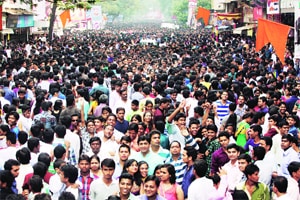27th Marathi Bhasha Diwas (Marathi Language Day) In Remembrance Of Famous Marathi Literatuerer `Kusumagraj` वि वा शिरवाडकर (V. V. Shirwadkar)

Published: Friday, February 22, 2013
 २७ तारखेला मातृभाषा दिन साजरा केला जाईल.. एखादा दिवस साजरा करणे खूप सोपं होत चालंय.. पण आपण खरोखर आपली मातृभाषा टिकावी म्हणून काही प्रयत्न करतोय का? किंवा करायला हवेत तर कोणते? सांगतोय स्वरूप पंडित
२७ तारखेला मातृभाषा दिन साजरा केला जाईल.. एखादा दिवस साजरा करणे खूप सोपं होत चालंय.. पण आपण खरोखर आपली मातृभाषा टिकावी म्हणून काही प्रयत्न करतोय का? किंवा करायला हवेत तर कोणते? सांगतोय स्वरूप पंडितभारतात 'कॉमन मिनिमम प्रोग्राम' अर्थात किमान समान कार्यक्रम ही संकल्पना सर्वपरिचित आहे. सरकार कोणतीही योजना आखत असते वेळी एक दिशादशर्क म्हणून या संकल्पनेचा उपयोग होतो. आर्थिकदृष्टय़ा मागास, शोषित-वंचित अशा घटकांना त्यांचे हक्काचे स्थान मिळावे अशी या कार्यक्रमामागील भूमिका असते. पण आपलेच संवेदनशून्य होत जाणारे मन सध्या हे जणू विसरत चालले आहे की, आपली भाषा- आपली मातृभाषा हीसुद्धा जागतिक भाषेच्या रेटय़ासमोर- प्रसारमाध्यमांच्या प्रभावाद्वारे तिच्या हक्कांपासून वंचित होते आहे. आपल्याच मातृभाषेपासून आपण दुरावत आहोत. भाषेच्या शुद्धतेला आपण पारखे होत आहोत. एकीकडे इंग्रजीसारख्या भाषेचा द्वेष तर करायचा नाहीच; किंबहुना त्याचे ज्ञानही मिळवायचे हे आव्हान आहेच.. त्याचबरोबरीने आपली भाषा समृद्ध करायची, तिचा वापर-प्रसार करायचा आणि तिचे चिरंतनत्व अबाधित राखायचे हेसुद्धा मोठे आव्हान आहे.
मला याच पाश्र्वभूमीवर महात्मा गांधीजी आठवतात. सर्वस्वाचा त्याग करणाऱ्या क्रांतिकारकांबद्दल तत्कालीन भारतीय जनतेच्या मनात आदर होताच, पण त्या तुलनेत महात्मा गांधीजींबद्दल मनात असलेला आदर सक्रिय सहभागातून व्यक्तही होत होता. यामागील रहस्य कोणते असावे? तर उत्तर सोपे आहे. गांधीजींनी देशभक्तीची व्याख्या सोप्या सोप्या आणि सर्वाना सहज जमू शकतील अशा लहान लहान कृतींनी मांडली. त्यात चरख्यावरील सूतकताईचा समावेश होता, त्यात गोशाळा चालविणे होते, त्यात खादीचा वापर
 होता, प्रभात फेऱ्या काढणे होते, वंदे मातरम् म्हणणे होते.. अशा अनेक लहान लहान कृतींतून सामान्य माणसाला आपण देशासाठी काहीतरी करत असल्याची अभिमानास्पद जाणीव करून दिली जात होती. तत्कालीन बलाढय़ ब्रिटनच्या आव्हानासमोर गांधीजींच्या या कृती कार्यक्रमाने प्रतिआव्हान निर्माण केले.
होता, प्रभात फेऱ्या काढणे होते, वंदे मातरम् म्हणणे होते.. अशा अनेक लहान लहान कृतींतून सामान्य माणसाला आपण देशासाठी काहीतरी करत असल्याची अभिमानास्पद जाणीव करून दिली जात होती. तत्कालीन बलाढय़ ब्रिटनच्या आव्हानासमोर गांधीजींच्या या कृती कार्यक्रमाने प्रतिआव्हान निर्माण केले.मला आज हे आठवले. कारण आपणही आपल्या भाषेच्या समोर उभ्या ठाकलेल्या आव्हानांना विनम्रतापूर्वक आणि अन्य भाषांचा जराही द्वेष मनात येऊ न देता प्रतिआव्हाने निर्माण नाही का करू शकणार? आजचे युग हे माहिती-तंत्रज्ञानाचे युग मानले जाते. संपर्क-क्रांतीचे युग मानले जाते. अशा वेळी आपण आपल्या दैनंदिन जीवनात अशाच छोटय़ा छोटय़ा कृतींनी काहीच नाही का करू शकणार? भाषेच्या जाज्वल्य नाही तरी किमान मनस्वी अभिमानातून आपण किमान एखादी तरी कृती नाही का फुलवू शकणार? भाषेसाठी सर्वस्वाचा त्याग करणाऱ्या सक्रिय कार्यकर्त्यांना आपल्या परीने नाही का सहकार्य करू शकणार? मला वाटतं की हे फारसं अशक्य नाही. उलट या कृतींनी आपल्यालाच 'अल्प योगदान' दिल्याचे समाधान लाभू शकेल. हा 'किमान भाषा वापर' असा कार्यक्रम नसून उलट किमान समान कार्यक्रमाच्या धर्तीवर आणि महात्मा गांधीजींनी घालून दिलेल्या आदर्शांवर आधारित 'भाषा संवर्धन आणि प्रसार कार्यक्रम' आहे. काय आहेत या कृती?
ल्ल जी बाब एसएमएसची तीच ई-मेलचीसुद्धा! आपल्याला सध्या सर्वच संकेतस्थळांद्वारे 'फोनेटिक' (उच्चारावरून शब्द) पद्धतीने अनेक भाषांत ई-मेल पाठविण्याची सुविधा आहे. ठरवून आपण दिवसभरात किमान एक ई-मेल मराठीतून नक्कीच करू शकतो.
बँका, विमा कंपन्या, चल ध्वनी कंपन्या यांच्याकडे मराठीतून माहिती- सूचना पुस्तिका- प्रपत्रे (फॉम्र्स) इत्यादी देण्याचा आग्रह करणे.
आजची तरुण पिढी, त्यांची 'सेलिब्रेट' करण्याची वृत्ती, त्यांचे माहिती-तंत्रज्ञानावरील प्रेम, करमणूकप्रधान समाजरचना, दिन-विशेष असे बिंदू लक्षात घेऊन हा कार्यक्रम मी तयार केला आहे. त्यात जेवढी भर घालता येईल अर्थात जेवढी कृतिशील भर घालता येईल तेवढे उत्तमच!
आपल्या प्रतिसादाच्या अपेक्षेत..!
नमस्कार मित्रानो,
सर्वाना मराठी भाषा दिनाच्या हार्दिक शुभेच्या. कविश्रेष्ठ कुसुमाग्रज यांच्या जयंतीच्या दिवशी प्रतिवर्षी २७ फेब्रुवारी हा दिवस मराठी भाषा दिन म्हणून साजरा करण्यात येतो .या दिवशी पासून आपण एक संकल्प करू कि मराठी भाषा आणि मराठी माणूस हा जगात आपली कीर्ती गाजवेल आणि या साठी आपण सर्वोतोपरी प्रयत्न करू. ....आपली मराठी भाषा हि जगातील प्रत्येक व्यक्तीच्या तोंडी असावी हि इच्छा प्रत्येकाने मनात बाळगून आपली मराठीचा झेंडा अटकेपार जावा यासाठी प्रयत्न करायला हवेत. तरच खऱ्या अर्थाने आपण मराठी आहोत असा म्हणता येईल.!!!
लाभले आम्हास भाग्य बोलतो मराठी
जाहलो खरेच धन्य ऎकतो मराठी
धर्म पंथ जात एक जानतो मराठी
ऎवढ्या जगात माय मानतो मराठी
बोलतो मराठी ऎकतो मराठी
जानतो मराठी मानतो मराठी
आमच्या मना मनात दंगते मराठी
आमच्या रगा रगात रंगते मराठी
आमच्या मना मनात दंगते मराठी
आमच्या रगा रगात रंगते मराठी
आमच्या उरा उरात स्पंदते मराठी
आमच्या नसा नसात नाचते मराठी॥
आमच्या पिलापिलात जन्मते मराठी
आमच्या लहानग्यात रांगते मराठी
आमच्या मुलामुलीत खेळते मराठी
आमच्या घराघरात वाढते मराठी
आमच्या फ़ुलाफ़ुलात नांदते मराठी
येथल्या फ़ुलाफ़ुलात भासते मराठी
येथल्या दिशा दिशात दाटते मराठी
येथल्या नगा नगात गर्जते मराठी
येथल्या दरीदरीत हिंडते मराठी
येथल्या वनावनात गुंजते मराठी
येथल्या दरीदरीत धुंदते मराठी
येथल्या वनावनात गुंजते मराठी
येथल्या तरुलतात साजते मराठी
येथल्या कळिकळित लाजते मराठी॥
येथल्या नभामधुन वर्षते मराठी
येथल्या पिकांमधुन डोलते मराठी
येथल्या नद्यांमधुन वाहते मराठी
येथल्या चराचरात राहते मराठी॥
लाभले आम्हास भाग्य बोलतो मराठी
जाहलो खरेच धन्य ऎकतो मराठी
बोलतो मराठी ऎकतो मराठी
जानतो मराठी मानतो मराठी
दंगते मराठी... रंगते मराठी..
स्पंदते मराठी.. स्पर्शते मराठी..
गुंजते मराठी.. गर्जते मराठी.. गर्जते मराठी.. गर्जते मराठी ||
आंतरजालावरून साभार - ई-मेल फॉरवर्ड - आभार - लेखक / कवी
सर्वाना मराठी भाषा दिनाच्या हार्दिक शुभेच्या. कविश्रेष्ठ कुसुमाग्रज यांच्या जयंतीच्या दिवशी प्रतिवर्षी २७ फेब्रुवारी हा दिवस मराठी भाषा दिन म्हणून साजरा करण्यात येतो .या दिवशी पासून आपण एक संकल्प करू कि मराठी भाषा आणि मराठी माणूस हा जगात आपली कीर्ती गाजवेल आणि या साठी आपण सर्वोतोपरी प्रयत्न करू. ....आपली मराठी भाषा हि जगातील प्रत्येक व्यक्तीच्या तोंडी असावी हि इच्छा प्रत्येकाने मनात बाळगून आपली मराठीचा झेंडा अटकेपार जावा यासाठी प्रयत्न करायला हवेत. तरच खऱ्या अर्थाने आपण मराठी आहोत असा म्हणता येईल.!!!
To Use on orkut, facebook, hi5 etc?
1) Right Click on image
2) Click on Copy image location
3) and Paste in friends scrapbook for wishes :)
1) Right Click on image
2) Click on Copy image location
3) and Paste in friends scrapbook for wishes :)
लाभले आम्हास भाग्य बोलतो मराठी
जाहलो खरेच धन्य ऎकतो मराठी
धर्म पंथ जात एक जानतो मराठी
ऎवढ्या जगात माय मानतो मराठी
बोलतो मराठी ऎकतो मराठी
जानतो मराठी मानतो मराठी
आमच्या मना मनात दंगते मराठी
आमच्या रगा रगात रंगते मराठी
आमच्या मना मनात दंगते मराठी
आमच्या रगा रगात रंगते मराठी
आमच्या उरा उरात स्पंदते मराठी
आमच्या नसा नसात नाचते मराठी॥
आमच्या पिलापिलात जन्मते मराठी
आमच्या लहानग्यात रांगते मराठी
आमच्या मुलामुलीत खेळते मराठी
आमच्या घराघरात वाढते मराठी
आमच्या फ़ुलाफ़ुलात नांदते मराठी
येथल्या फ़ुलाफ़ुलात भासते मराठी
येथल्या दिशा दिशात दाटते मराठी
येथल्या नगा नगात गर्जते मराठी
येथल्या दरीदरीत हिंडते मराठी
येथल्या वनावनात गुंजते मराठी
येथल्या दरीदरीत धुंदते मराठी
येथल्या वनावनात गुंजते मराठी
येथल्या तरुलतात साजते मराठी
येथल्या कळिकळित लाजते मराठी॥
येथल्या नभामधुन वर्षते मराठी
येथल्या पिकांमधुन डोलते मराठी
येथल्या नद्यांमधुन वाहते मराठी
येथल्या चराचरात राहते मराठी॥
लाभले आम्हास भाग्य बोलतो मराठी
जाहलो खरेच धन्य ऎकतो मराठी
बोलतो मराठी ऎकतो मराठी
जानतो मराठी मानतो मराठी
दंगते मराठी... रंगते मराठी..
स्पंदते मराठी.. स्पर्शते मराठी..
गुंजते मराठी.. गर्जते मराठी.. गर्जते मराठी.. गर्जते मराठी ||
आंतरजालावरून साभार - ई-मेल फॉरवर्ड - आभार - लेखक / कवी





















No comments:
Post a Comment